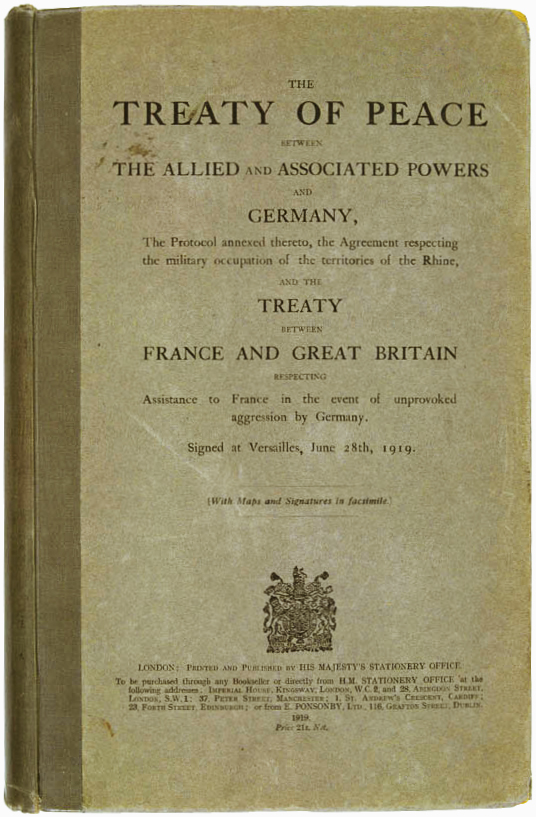Ondertekening van het Verdrag van Versailles
= Verdrag van Versailles 28 juni 1919 =
Versailles, Treaty of, peace Versailles, Treaty of, peace treaty signed at the end of World War I between Germany and the Allies. It was negotiated during the Paris Peace Conference held in Versailles beginning January 18, 1919. Represented were the United States, Great Britain, France, and Italy; the German Republic, which had replaced the imperial German government at the end of the war, was excluded from the parley. Included in the first section of the treaty was the Covenant of the League of Nations, the world’s first peacekeeping body, which was given the responsibility for executing the terms of the various treaties negotiated after World War I. The treaty was signed on June 28, 1919, in the Hall of Mirrors at the Palace of Versailles near Paris. (The U.S. did not ratify the agreement but signed a separate Treaty of Berlin with Germany on July 2, 1921.) Disarmament and Reparations
By the Treaty of Versailles, Germany was required to abolish compulsory military service; to reduce its army to 100,000; to demilitarize all the territory on the left bank of the Rhine River and also that on the right bank to a depth of 50 km (31 mi); to stop all importation, exportation, and nearly all production of war material; to limit its navy to 24 ships, with no submarines, the naval personnel not to exceed 15,000; and to abandon all military and naval aviation by October 1, 1919. Germany also agreed to permit the trial of former emperor William II by an international court on the charge of “a supreme offense against international morality.” (The trial never took place.) For damage incurred by the Allied powers during the war, Germany was required to make extensive financial reparation. In addition to money, payment was made in the form of ships, trains, livestock, and valuable natural resources. Difficulty arose in collecting payment, and the situation was not finally settled until the Lausanne Conference in 1932. Territorial Changes Germany recognized the unconditional sovereignty of Belgium, Poland, Czechoslovakia (now the Czech Republic and Slovakia), and Austria and denounced the treaties of Brest-Litovsk and Bucharest. In addition, it lost some 71,000 sq km (about 27,500 sq mi), or slightly more than 13 percent of its European domain. Alsace-Lorraine was returned to France, and the Saar basin placed under a League of Nations Commission for 15 years. Belgium received the small districts of Eupen, Malmédy, and Moresnet. Under plebiscites held in 1920 to determine the status of northern and central Schleswig, the former, comprising 3981 sq km (1537 sq mi), was reunited with Denmark, but the latter remained with Germany. To Poland were ceded large parts of the provinces of Posen and West Prussia. Plebiscites in southeastern Prussia and the Marienwerder district of West Prussia, held in 1920, produced substantial majorities for Germany. The plebiscite in Upper Silesia in 1921 gave a majority for Germany, but the Council of the League of Nations, having been invited to settle the controversy, awarded the richest part of the region to Poland. A portion of Upper Silesia (now in the Czech Republic) was ceded to Czechoslovakia in 1920. The port of Memel with adjacent territory was ceded to the Allies for ultimate transfer to Lithuania. The port of Danzig was ceded to the principal Allied and associated powers, which recognized Danzig (now Gdansk) as a free city administered under the League of Nations but subject to Polish jurisdiction in regard to customs and foreign relations. Germany also lost its entire colonial empire.
